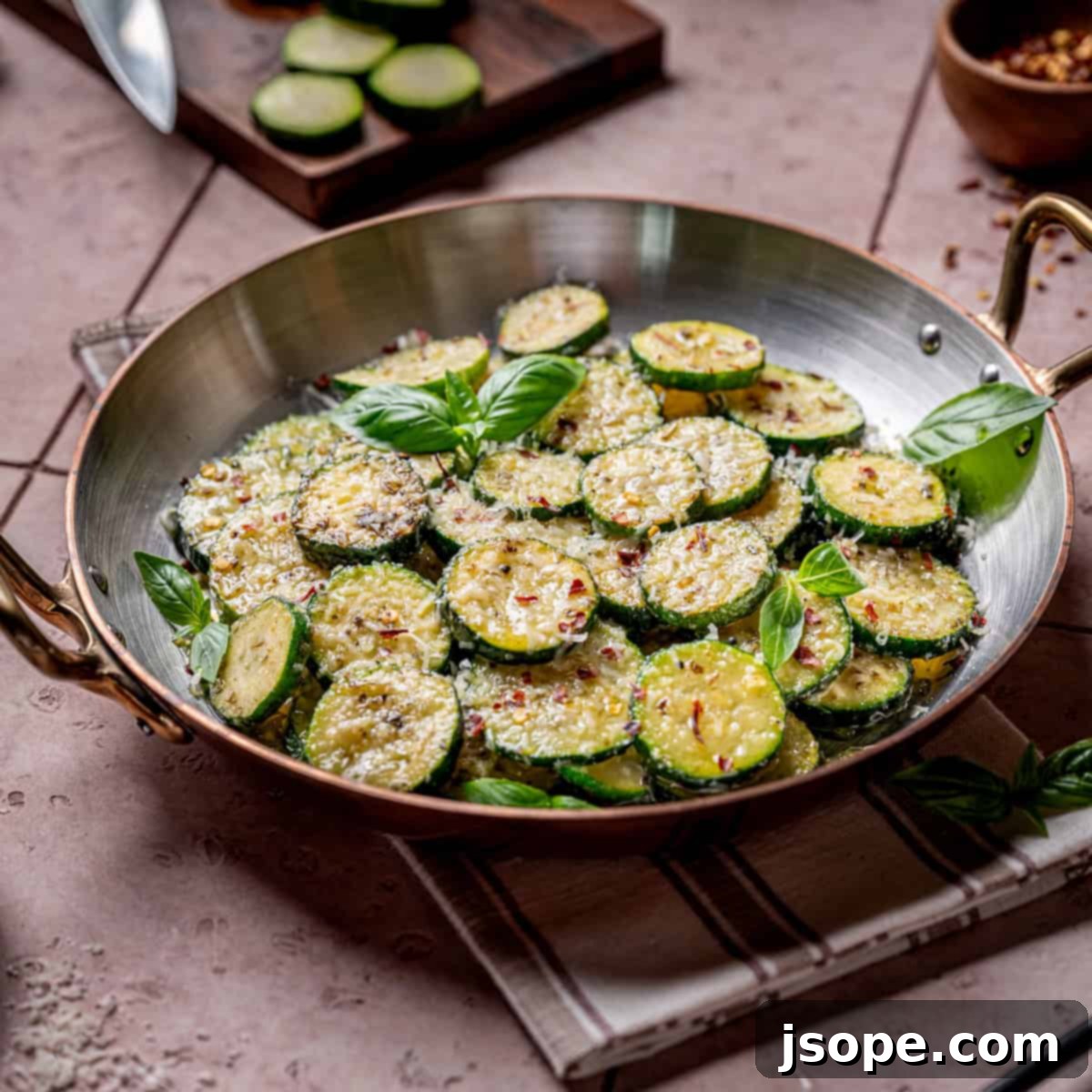Zucchini, a quintessential summer squash, graces our tables with its versatile charm and abundant availability during its peak season. While this delightful vegetable can be prepared in myriad ways, few methods rival the sheer simplicity and deliciousness of a quick sauté. This effortless cooking technique transforms fresh zucchini into a vibrant, tender, and incredibly flavorful side dish, perfectly complementing a wide array of main courses. Our cherished Sautéed Zucchini with Italian Herbs & Parmesan recipe is a go-to for summer meals, pairing beautifully with grilled chicken, savory pork, and robust red meats, bringing a taste of the Mediterranean to your plate all season long.
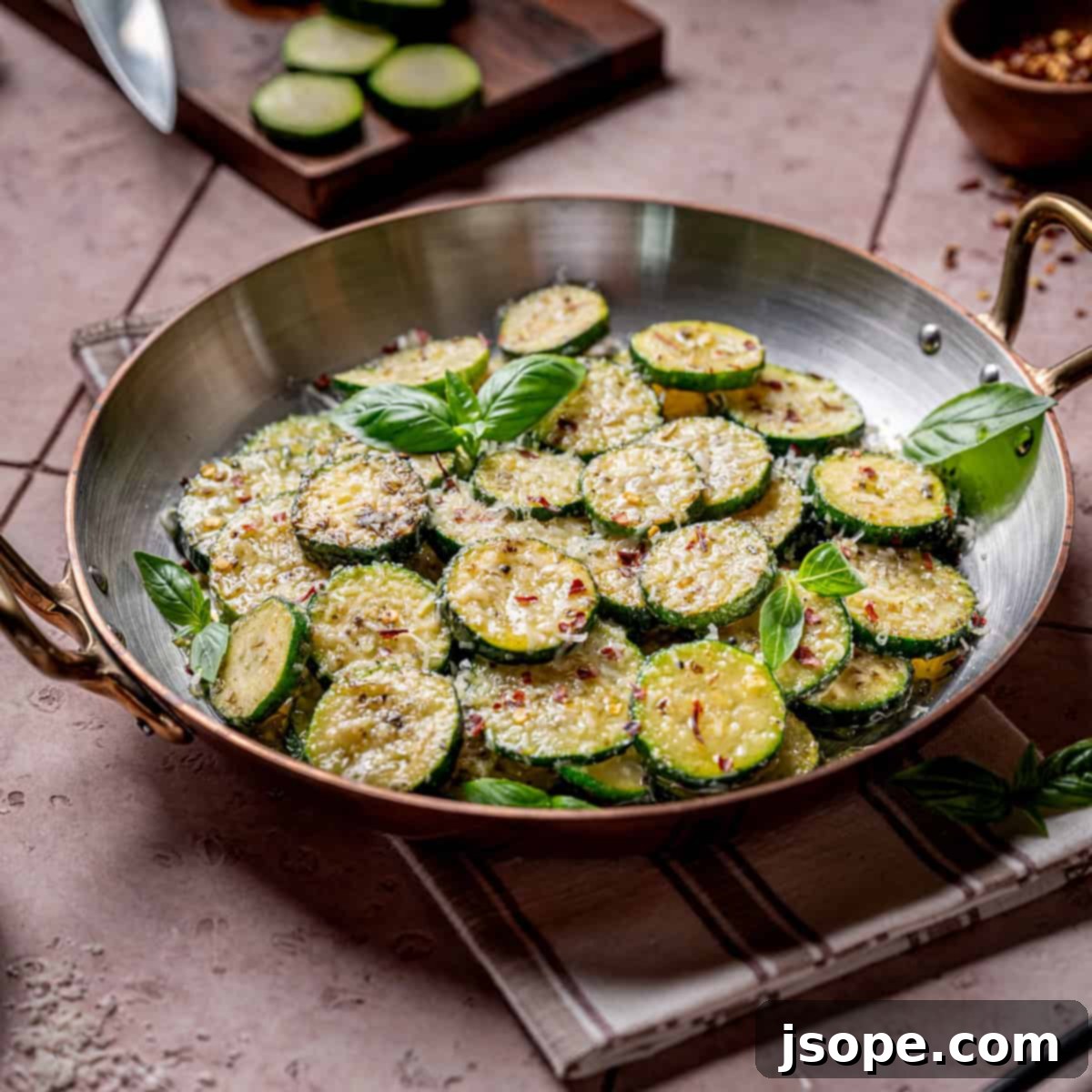
If you’re continually seeking out easy yet impactful vegetable side dishes to elevate your everyday meals, we highly recommend exploring some of our other favorites. Dive into the bold flavors of our Spicy Charred Calabrian Chili Broccolini for a kick, or savor the elegant simplicity of Easy Sautéed Balsamic Asparagus with Parmesan. Each offers a unique way to bring fresh, healthy vegetables to the forefront of your dining experience.
Why This Sautéed Zucchini Recipe Will Become Your Summer Staple
Our Italian Herb Sautéed Zucchini isn’t just a recipe; it’s a testament to the beauty of simple, fresh ingredients expertly prepared. Here’s why this dish is destined to become a beloved fixture in your kitchen:
- Effortless Preparation: This easy sautéed zucchini recipe truly requires no specialized kitchen equipment. A single large sauté pan is all you need, making cleanup a breeze and cooking accessible to everyone, regardless of their culinary gadget collection.
- Lightning-Fast Cook Time: From start to finish, this dish comes together in under 10 minutes. It’s the perfect solution for busy weeknights, last-minute gatherings, or when you simply crave a fresh, homemade side without the fuss.
- Maximizing Seasonal Abundance: When zucchini is at its prime, fresh, affordable, and plentiful during the summer months, this recipe offers a fantastic way to utilize your garden harvest or farmers’ market finds, ensuring nothing goes to waste.
- A Healthy & Wholesome Choice: Zucchini is naturally low in calories and carbohydrates, rich in essential vitamins (like C and B6), minerals, and dietary fiber. Sautéing it lightly preserves its nutritional integrity, making it an incredibly healthy addition to any meal.
- Unmatched Versatility: This subtly seasoned zucchini side dish boasts incredible adaptability. Its mild yet aromatic flavor profile makes it a perfect companion for a diverse range of main courses, from poultry and fish to red meats and vegetarian entrées.
Exploring Zucchini: More Ways to Enjoy This Adaptable Squash
Zucchini squash is celebrated globally for its culinary versatility, lending itself beautifully to an astonishing array of preparations. Beyond the simple sauté, which perfectly highlights its delicate flavor and tender texture, zucchini can be transformed to suit any meal or occasion. Here are just a few ideas to inspire your next zucchini creation:
- Roasting: Toss zucchini slices or chunks with olive oil, salt, pepper, and your favorite herbs, then roast in a hot oven until tender-crisp and lightly caramelized for a hands-off side dish.
- Grilling: Sliced lengthwise or into thick rounds, zucchini takes on a delightful smoky char when grilled, making it an excellent addition to summer barbecues. Brush with a simple marinade or herb oil before grilling.
- Stuffing: Larger zucchini can be halved, hollowed out, and filled with a savory mixture of breadcrumbs, cheese, herbs, ground meat, or other vegetables, then baked until tender and bubbly.
- “Zoodles”: For a healthy, low-carb alternative to pasta, spiralize zucchini into “zoodles.” These can be quickly sautéed, lightly boiled, or even enjoyed raw with your favorite sauce.
- Baking: Zucchini is a popular ingredient in baked goods, adding moisture and nutrients to breads, muffins, and cakes. It’s also excellent in savory bakes like gratins and casseroles.
- Raw Applications: Don’t overlook raw zucchini! Thinly sliced or julienned, it adds a refreshing crunch to salads, slaws, or can be served as part of a crudité platter with your favorite dips.
- Frying: Think zucchini fritters or tempura for a crispy, indulgent treat.
- Soups & Stews: Zucchini melts beautifully into broths, adding body and a subtle sweetness to summer soups and vegetable stews.
With so many ways to prepare it, zucchini truly is a culinary chameleon, capable of fitting into virtually any dish!
If your love for zucchini runs as deep as ours, you’ll definitely want to explore these other fantastic recipes that celebrate this incredible vegetable:
- Baked Zucchini Parmigiana – Easy al Forno Recipe: A comforting, cheesy baked dish that’s a true crowd-pleaser.
- Spaghetti alla Nerano (Cheesy Fried Zucchini Pasta): A classic Italian pasta dish featuring tender, fried zucchini and plenty of cheese.
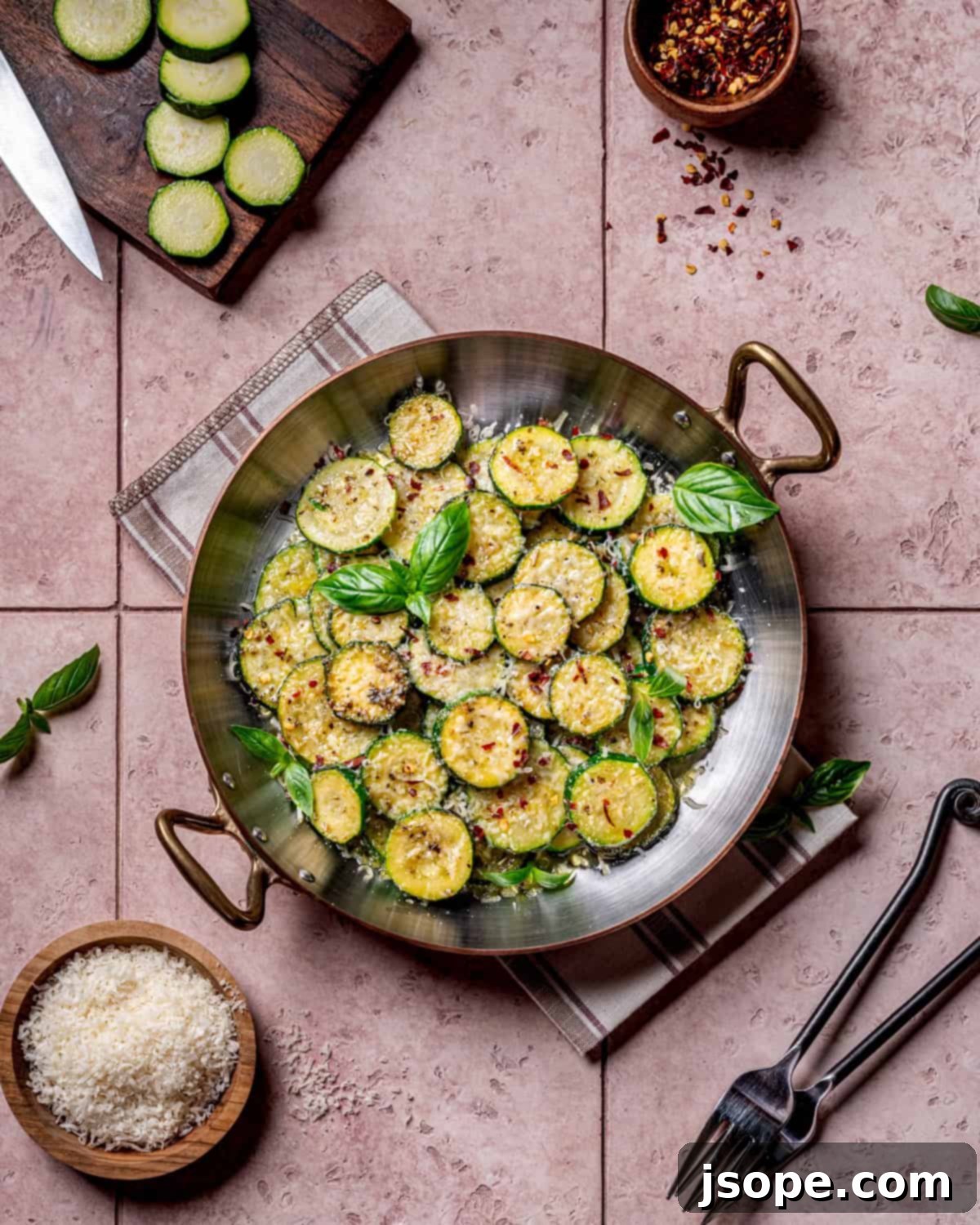
Key Ingredients for Flavorful Sautéed Zucchini
Achieving perfectly sautéed zucchini with rich Italian flavors relies on a few simple, high-quality ingredients. Here’s a closer look at what you’ll need and why each component is important:
- Fresh Zucchini: Opt for small to medium-sized zucchini that are firm and blemish-free. These tend to have fewer seeds and more tender flesh. Slicing them into consistent ¼-inch rounds or half-moons ensures even cooking.
- High-Quality Olive Oil: Extra virgin olive oil is crucial for sautéing, providing a rich, fruity base flavor and helping the zucchini achieve that desirable golden-brown sear without burning.
- Kosher Salt and Freshly Ground Black Pepper: These fundamental seasonings enhance the natural sweetness of the zucchini and tie all the flavors together. Kosher salt is preferred for its coarser texture and cleaner taste.
- Dried Italian Herbs: A blend of dried thyme, basil, marjoram, and oregano creates the classic aromatic profile of Italian cuisine. These herbs infuse the zucchini with deep, savory notes as they cook.
- Garlic Powder: This provides a mild, consistent garlic flavor that disperses evenly throughout the dish without the risk of fresh garlic burning during the quick sauté. It’s important to use garlic powder, not garlic salt, to control the overall sodium content.
- Parmesan Cheese: A generous sprinkle of freshly grated Parmigiano Reggiano is a game-changer. Its salty, umami-rich flavor adds complexity and depth, elevating simple squash to something truly special. Avoid pre-grated varieties for the best taste and texture.
- Fresh Basil: A final flourish of fresh basil leaves, chiffonade or torn, adds a burst of vibrant color and a fresh, herbaceous aroma that brightens the entire dish upon serving.
For precise measurements, please refer to the detailed recipe card below.
Smart Substitutions & Dietary Adjustments
This recipe is incredibly flexible and can be easily adapted to suit different preferences or dietary needs. Here are a few common and effective substitutions:
- Zucchini Alternatives: If zucchini isn’t available or you’d like to try something different, common yellow squash or calabaza squash make excellent substitutes. They share similar textures and cooking times, absorbing the flavors beautifully.
- Cheese Options (or Omission): For a vegan dish, simply omit the Parmesan cheese. Alternatively, you can replace Parmesan with a good quality Pecorino Romano for a sharper, saltier kick, or Grana Padano for a slightly milder, nutty flavor. Nutritional yeast can also be a great dairy-free alternative to add a cheesy umami note.
- Herb Variations: Feel free to experiment with other dried or fresh herbs. A touch of dried rosemary, a sprinkle of fresh parsley, or a pinch of red pepper flakes for a subtle heat can all add interesting twists.
- Oil Choices: While olive oil is recommended for its flavor, avocado oil or grapeseed oil can also be used for sautéing if you prefer a neutral-tasting oil with a high smoke point.
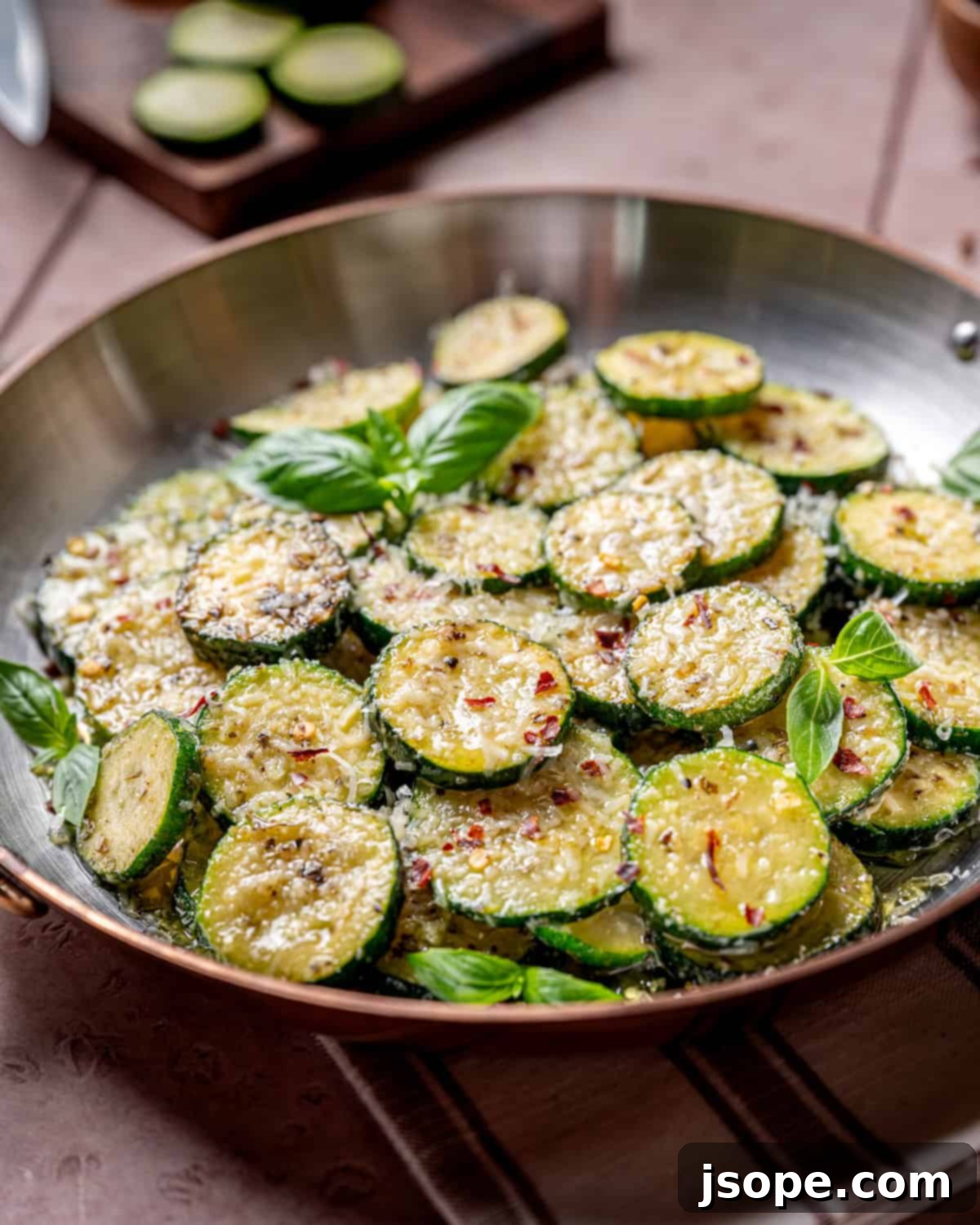
Mastering Sautéed Zucchini: A Simple Overview
The beauty of this summer side dish lies in its simplicity and speed. Mastering perfectly sautéed zucchini involves just a few straightforward steps: prepare your zucchini by slicing, quickly sauté it in hot olive oil with a thoughtful blend of Italian herbs and garlic powder, and then finish by tossing with grated Parmesan and fresh basil. The goal is tender-crisp zucchini with a beautiful golden hue, not soggy or overcooked. This method brings out the natural sweetness of the squash while infusing it with aromatic herbs for a truly delightful experience.
Essential Equipment for This Quick Recipe
One of the many advantages of this sautéed zucchini recipe is its minimalist equipment requirements. You won’t need any fancy gadgets or specialized tools, just a few kitchen basics:
- A large sauté pan: A 10-12 inch non-stick or cast-iron pan is ideal. Its wide surface allows the zucchini slices to cook in a single layer, promoting even browning and preventing steaming.
- A sturdy spatula or tongs: Essential for tossing and stirring the zucchini evenly as it cooks.
- A sharp knife and cutting board: For preparing the zucchini slices.
- A grater: For freshly grating the Parmesan cheese, which significantly enhances flavor.
That’s it! With these simple tools, you’re ready to create a delicious and healthy side dish.
Step-by-Step Guide to Perfectly Sautéed Zucchini
Follow these detailed steps to achieve tender, flavorful sautéed zucchini every time:
1. Prepare the Zucchini
- Begin by thoroughly washing your zucchini under cool running water. Pat them dry with a clean kitchen towel or paper towel. Moisture on the zucchini can lead to steaming instead of sautéing, which prevents a good sear.
- Using a sharp knife, trim off both ends of each zucchini. Then, slice the zucchini into uniform ¼-inch thick rounds or half-moons. Consistency in thickness is key for even cooking. If you have very large zucchini, consider halving them lengthwise before slicing to create bite-sized half-moon shapes.
2. Sauté the Zucchini to Golden Perfection
- Place a large sauté pan (10-12 inches is ideal) over medium heat. Add the olive oil and allow it to heat until it shimmers slightly but isn’t smoking. This ensures the zucchini begins to cook immediately upon contact.
- Carefully add the sliced zucchini to the hot pan. Spread them out as much as possible, trying not to overcrowd the pan. If necessary, work in two batches to avoid steaming.
- Toss the zucchini gently to ensure all pieces are lightly coated in the hot olive oil.
- Immediately sprinkle the zucchini with the kosher salt, black pepper, garlic powder, and your blend of dried herbs (thyme, basil, marjoram, and oregano).
- Continue to cook, stirring and tossing the zucchini frequently for approximately 5-7 minutes. The goal is for the zucchini to become tender-crisp and develop a beautiful golden-brown color on the edges, indicating caramelization and enhanced flavor. Avoid overcooking, which can lead to a mushy texture.
3. Finish and Serve
- Once the zucchini reaches your desired tenderness and color, remove it from the heat and transfer it to a warm serving dish.
- Generously sprinkle the freshly grated Parmesan cheese over the hot zucchini. The residual heat will slightly melt the cheese, enhancing its flavor and adherence.
- Finally, scatter the chiffonade or torn fresh basil leaves over the top. The fresh basil adds a burst of vibrant color and a refreshing aromatic finish.
- Serve immediately as a delightful side dish to your chosen main course.
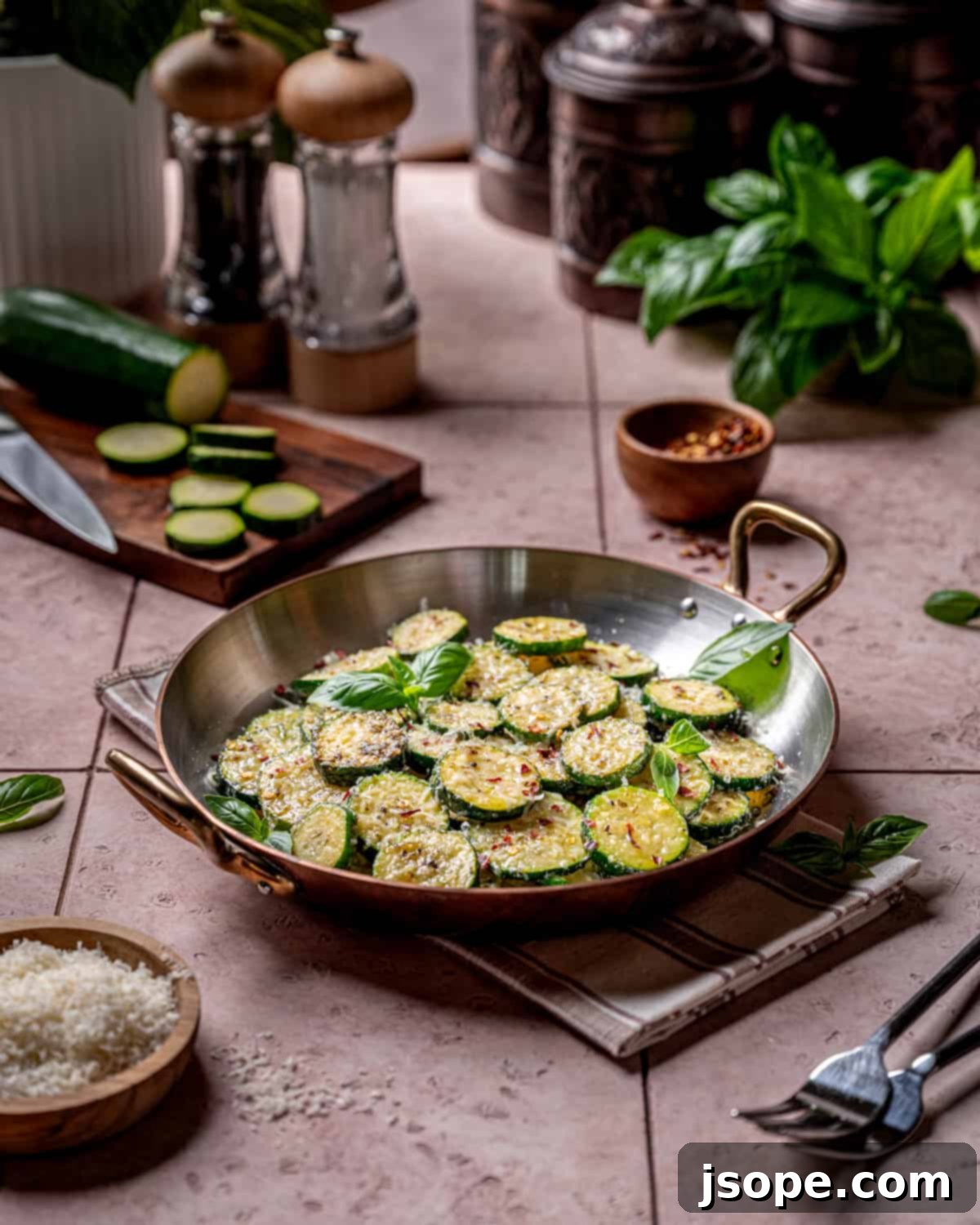
Creative Variations & Flavor Boosters
This simple sautéed zucchini recipe serves as an excellent canvas for culinary creativity. Don’t hesitate to personalize it with these delicious variations:
- Tomato & Herb Zucchini: For a heartier side, stir in a quarter cup of your favorite tomato sauce or a handful of chopped cherry tomatoes during the last minute of cooking. This adds a lovely tang and extra juiciness.
- Added Texture & Crunch: Introduce a delightful textural contrast by sprinkling toasted sunflower seeds, pumpkin seeds (pepitas), slivered almonds, or even some crispy toasted panko breadcrumbs on top just before serving.
- Turn Up the Heat: If you enjoy a little spice, add a pinch of crushed red pepper flakes along with the other seasonings, or stir in a teaspoon of Calabrian chili paste for a more intense, smoky heat.
- Citrus Brightness: A squeeze of fresh lemon juice or a hint of lemon zest just before serving can brighten all the flavors and add a refreshing finish.
- Fresh Herb Medley: While dried Italian herbs are convenient, feel free to use a mix of fresh herbs like finely chopped rosemary, thyme, and oregano for an even more vibrant aroma and taste.
- Onion & Bell Pepper Infusion: Sauté a quarter cup of finely diced onion or bell pepper for a few minutes before adding the zucchini to build a more complex flavor base.
- Balsamic Glaze: A drizzle of balsamic glaze (reduced balsamic vinegar) adds a sweet and tangy counterpoint that pairs beautifully with the savory herbs and Parmesan.
Storage & Meal Prep Tips
Understanding how to properly store and reheat your sautéed zucchini ensures you can enjoy its delicious flavors even after the initial meal. However, it’s also important to manage expectations, as some dishes are best enjoyed fresh.
- How to Store Leftover Sautéed Zucchini: Once cooled, transfer any leftover sautéed zucchini to an airtight container. It will keep well in the refrigerator for up to 5 days. While still tasty, the texture will soften slightly upon storage.
How to Reheat Leftover Sautéed Zucchini:
- For best results, reheat cooked zucchini gently in a sauté pan over medium-low heat. Add a tiny splash of olive oil if needed to prevent sticking. Stir occasionally until warmed through. Avoid high heat or microwave reheating if possible, as it can make the zucchini overly soft or mushy.
Can You Freeze Sautéed Zucchini?
- Generally, freezing finished sautéed zucchini is not recommended for this particular dish. Zucchini has a high water content, and freezing cooked zucchini often results in a very soft, watery, and mushy texture upon thawing and reheating, significantly diminishing its appeal. While blanched zucchini can be frozen for use in soups or stews where texture is less critical, the quick and easy nature of this sautéed dish means it’s best enjoyed fresh or within a few days from the refrigerator.
Expert Tips for Perfect Sautéed Zucchini Every Time
Achieving perfectly tender, flavorful, and non-soggy sautéed zucchini is simple when you keep these crucial tips in mind:
- Don’t Overcook: This is arguably the most important tip. Zucchini cooks quickly. Aim for tender-crisp, not mushy. Overcooking will release too much water, leading to a soggy, lifeless dish.
- Control the Heat: Sauté over medium heat, not too high. High heat can cause the zucchini to burn before it softens, and it can also break down the olive oil, imparting an unpleasant bitter taste. Ensure the oil is hot before adding the zucchini.
- Avoid Overcrowding the Pan: Give the zucchini slices space. If you pack too many into the pan, they will steam instead of sauté, preventing them from developing that desirable golden-brown color and tender-crisp texture. Cook in batches if necessary.
- Consistent Slices: Cut your zucchini into uniform ¼-inch slices. This ensures that all pieces cook at roughly the same rate, preventing some from being undercooked while others are overcooked.
- Start with Dry Zucchini: Pat your zucchini dry after washing. Excess moisture will lower the pan’s temperature and cause the zucchini to steam rather than sear.
- Choose Smaller Zucchini: Smaller, thinner zucchini typically have a sweeter flavor, fewer seeds, and cook up more tender without becoming watery. Large, overgrown zucchini can sometimes develop a slightly bitter taste.
- Season Generously: Don’t be shy with the salt and pepper. Zucchini needs proper seasoning to bring out its best flavor. Adding the seasonings early in the cooking process allows them to infuse into the squash.
Ideal Pairings: What to Serve with Sautéed Zucchini
The beauty of this Italian herb sautéed zucchini lies in its versatility, making it a perfect accompaniment to almost any main course. Its fresh, herbaceous flavor profile complements a wide range of proteins and other dishes. Here are some of our favorite pairings:
- Poultry: Sautéed zucchini is fantastic with grilled or roasted chicken, such as Cheesy Pistachio Pesto Chicken, or with simple baked chicken breasts. Its light flavor provides a refreshing contrast.
- Beef: It pairs wonderfully with a succulent steak, like a Grilled Marinated Tri-Tip Steak, or any roasted beef dish. The freshness of the zucchini balances the richness of the meat.
- Pork: Serve it alongside pork chops, a tender Herb-Crusted Pork Tenderloin, or even grilled sausages for a complete and satisfying meal.
- Fish & Seafood: Delicate white fish like cod or halibut, or grilled shrimp, benefit from the simple and clean flavors of sautéed zucchini.
- Vegetarian Mains: Pair it with lentil loaf, hearty bean burgers, or a cheesy polenta for a wholesome vegetarian meal.
- Other Sides: For a more elaborate meal, combine it with a grain like quinoa or couscous, or a simple potato dish.
Wine Pairings for Sautéed Zucchini
Choosing the right wine can truly elevate your dining experience. For a light and fresh side dish like sautéed zucchini, dry white wines are generally an excellent choice, but it can also stand up to certain reds, especially when paired with a red meat main course.
- Crisp White Wines: The bright, refreshing acidity and often herbaceous notes of wines like Sauvignon Blanc (especially from the Loire Valley or New Zealand), Pinot Grigio, or Vermentino beautifully complement the freshness of the zucchini and the Italian herbs. A dry unoaked Chardonnay can also work well, offering a bit more body without overpowering the dish.
- Mediterranean Whites: Wines indigenous to Italy or other Mediterranean regions, such as Verdicchio, Falanghina, or even a dry Rosé, often have the right balance of fruitiness and minerality to harmonize with the flavors of olive oil and fresh vegetables.
- Light-Bodied Reds: If your main course is red meat, a light-bodied red wine like a young Pinot Noir, a Bardolino, or a lighter Sangiovese can still pair nicely with the zucchini. These reds offer a fruit-forward profile and softer tannins that won’t clash with the delicate squash.
Ultimately, the best wine will often depend on the overall meal, but for the zucchini itself, a crisp, dry white wine will always be a delightful match.
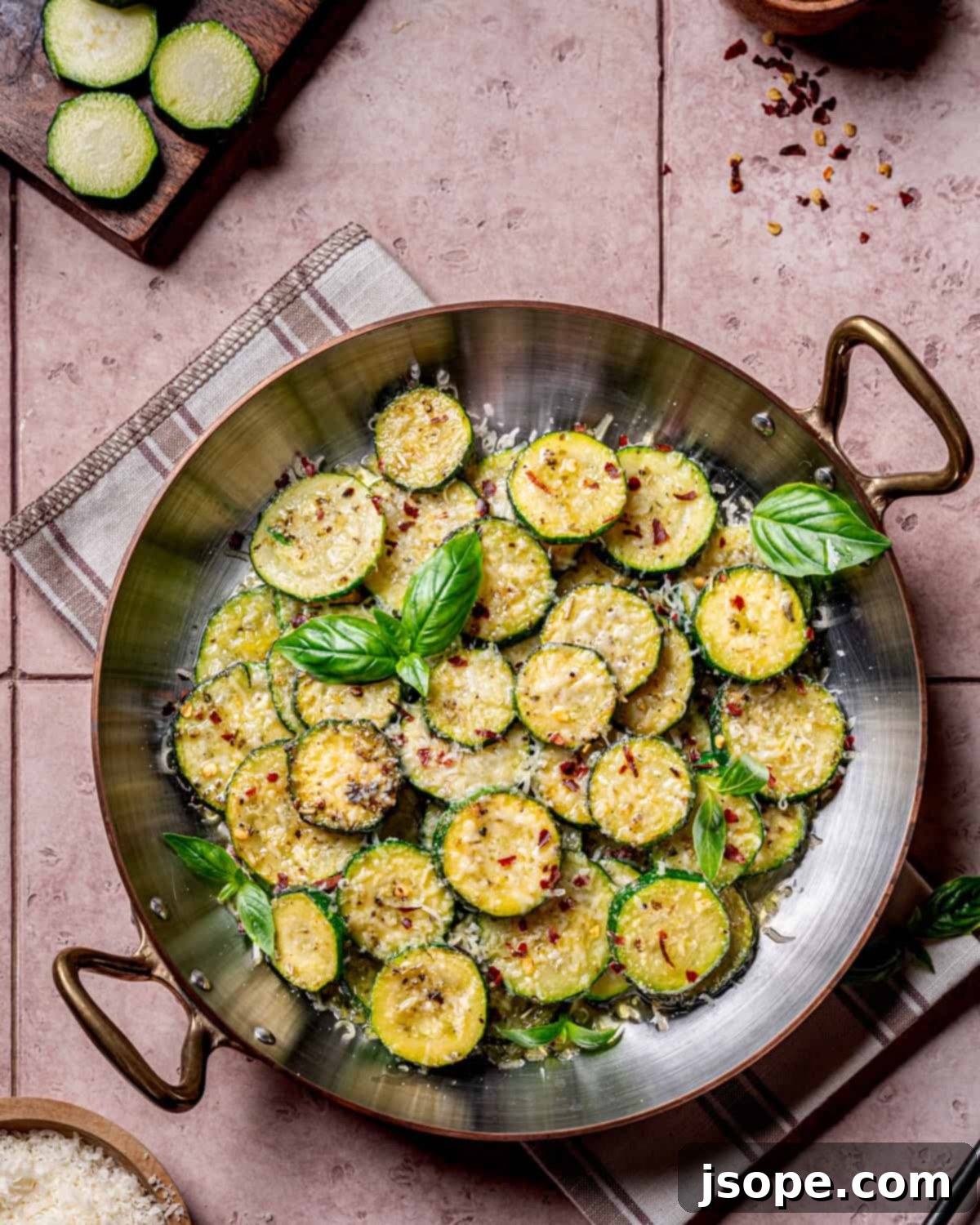
Frequently Asked Questions About Sautéed Zucchini
The key to avoiding soggy zucchini lies in a few steps. First, ensure your pan is hot and the olive oil is shimmering before adding the zucchini. Cook over medium heat – too low, and the zucchini will steam and get mushy; too high, and it might burn. Crucially, avoid overcrowding the pan; if necessary, cook in batches so the zucchini has room to sear and evaporate moisture rather than steam. Also, pat the zucchini dry before cooking.
For sautéing, consistency is key. Slice the zucchini into uniform ¼-inch rounds or half-moon shapes. If you have very large zucchini, you can halve them lengthwise before slicing to create more manageable, bite-sized half-moon pieces. Uniformity ensures even cooking.
Several factors can contribute to bitter sautéed zucchini. Firstly, choose smaller, younger zucchini, as larger, older ones can sometimes develop a slightly bitter compound. Secondly, avoid cooking on very high heat, which can break down the oil and the zucchini, leading to bitterness. Lastly, don’t cook the zucchini until it’s very dark brown or black; aim for a golden-brown sear. Beyond that point, the sugars can over-caramelize and turn bitter instead of sweet.
While you can cook frozen zucchini, it’s not recommended for this particular sautéed recipe. Frozen zucchini releases a lot of water as it thaws and cooks, making it very difficult to achieve that desirable tender-crisp texture and golden-brown sear. It will likely turn out quite mushy. This recipe is best made with fresh zucchini.
Extra virgin olive oil is highly recommended for this recipe. It imparts a delicious flavor that complements the Italian herbs beautifully. If you prefer a more neutral oil or need a higher smoke point, avocado oil or grapeseed oil are good alternatives.
More Delightful Side Dish Recipes
If you enjoyed this quick and flavorful sautéed zucchini, you’ll love exploring these other fantastic side dish recipes from our collection:
- Jalapeño Spinach Artichoke Dip Recipe
- Summer Farro Salad with Zucchini Asparagus and Feta
- White Wine Garlic Butter Sautéed Oyster Mushrooms
- Italian Herb Sautéed Zucchini Squash Recipe
Perfect Main Course Pairings
Elevate your meal with these fantastic main dishes that pair wonderfully with our Italian herb sautéed zucchini:
- Cheesy Pistachio Pesto Chicken with Roasted Cherry Tomatoes
- Braised Veal Shanks with Gremolata (Ossobuco Recipe)
- Chicken with Mushroom Marsala Sauce (Pollo al Marsala)
- Bone-In Veal Milanese Recipe (Cotoletta alla Milanese)
📖 Recipe: Italian Herb Sautéed Zucchini Squash

Italian Herb Sautéed Zucchini Squash Recipe
Pin Recipe
Equipment
- 1 Large sauté pan
Ingredients
- 4 zucchini small and thin
- 2 Tablespoons olive oil
- 1 teaspoon kosher salt
- ½ teaspoon black pepper
- Pinch dried thyme
- ½ teaspoon dried basil
- ½ teaspoon dried marjoram
- Pinch dried oregano
- ½ teaspoon garlic powder
- 3 Tablespoons parmesan cheese freshly grated
- 4 large basil leaves chiffonade or torn
Instructions
Slice the Zucchini
- Wash the zucchini and slice them into ¼” slices.4 zucchini
Sauté the Zucchini
- Heat the olive oil in a large sauté pan over medium heat. Once the oil is hot, add the zucchini to the hot pan. Toss to coat, then add the salt, pepper, garlic powder and dried herbs. Continue to cook, stirring and tossing often, until the zucchini are tender and begin to get a nice golden brown color – about 5 minutes.2 Tablespoons olive oil, 1 teaspoon kosher salt, ½ teaspoon black pepper, Pinch dried thyme, ½ teaspoon dried basil, ½ teaspoon dried marjoram, Pinch dried oregano, ½ teaspoon garlic powder
Finish the Dish
- Remove the zucchini to a serving dish, sprinkling with the parmesan. Add the fresh basil and serve.3 Tablespoons parmesan cheese, 4 large basil leaves
Notes
- Zucchini: Common yellow squash or calabaza squash can be substituted for zucchini in this recipe.
- Parmesan: This can be removed for a vegan dish or swapped for a good pecorino cheese or Grana Padano if desired.
Storage:
How to store leftover sautéed zucchini: Store in an airtight container in the fridge for up to 5 days.
How to reheat leftover sautéed zucchini: Simply reheat cooked zucchini in a sauté pan over medium-low heat until warmed through.
Top Tip: Don’t overcook the zucchini and don’t cook on too high of heat. Once it gets very dark brown or even black you will get a bitter taste that is very unpleasant.
Nutrition

